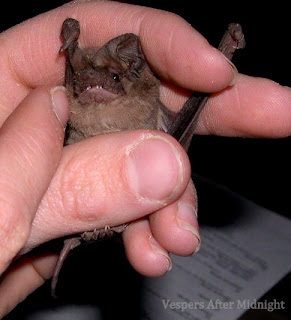There are over 1,200 species of bats in the world. They represent over 20% of all known mammals.
The smallest bat (and mammal) in the world is the bumblebee bat. It weighs less than half a penny and has a 3 inch wingspan.
The largest bats in the world are the giant flying foxes. They weigh around 3 pounds and have 6 foot wingspans. They are fruit eaters.
Bats are mammals. All mammals have fur, are warm-blooded, give birth to live young, and nourish those young with milk.
Bats are the only mammals that can fly. Flying squirrels glide, they are not capable of true powered flight.
Bat species have a wide variety of diets. A quick list from the most to least common: insects, fruit, nectar, carnivorous, fish, and blood.
Most bats eat insects. Insectivorous bats account for over 2/3rds of all known species and feed on insects such as mosquitos, moths, and crop pests such as the corn earworm and cotton bollworm. A little brown bat can eat up to 1,000 mosquito-sized insects in one hour! Collectively, insectivorous bats save U.S. farmers over $1 billion annually.
Over 200 species eat fruit (frugivorous bats). These bats live in the tropics where fruit can be found year round. Fruit eating bats play a critical role in rainforest regeneration by dispersing seeds. They also pollinate crops such as bananas, avocados, cashews, and figs.
More than 50 species feed on nectar and pollen (nectarivorous). These species are important pollinators for columnar cacti such as the saguaro and organ pipe as well as agaves. If you like margaritas thank this type of bat as they pollinate the agave that tequila is made from, the blue agave.
 |
| Mexican long-tongued bat (Choeronycteris mexicana). These guys feed on nectar from flowering columnar cacti. |
Around 7 species of bats eat small vertebrates such as frogs, birds, lizards, rodents, and even other bats (but not their own kind). These bats have a carnivorous diet.
About 5 species catch fish and aquatic insects (piscivorous). These bats have elongated hind feet they drag through the water to scoop up fish. Their echolocation is so fine they can detect a ripple on the water as fine as a human hair.
The vampire bats are by far the most famous bats, however their diet is the least common. There are only 3 species of bats that drink blood (a sanguivorous diet). These species are only found in Central and South America. Two of these species feed only on birds and 1 feeds on mammals. Vampire bats do not suck blood, they actually lap up the blood with their tongues like kittens. An anticoagulant in their saliva is being adapted for the treatment of stroke patients.
Bats are found on all continents except Antarctica. There are 45 species of bats found in the United States. Texas has the most species at 32, but Arizona is a close second with 28 species.
The largest known bat colony in the world is Bracken Cave in Central Texas. Over 20 million Mexican free-tailed bats (Tadarida brasiliensis) roost in the cave and collectively eat over 200 tons of insects EACH NIGHT (200 tons is approximately equal to 2 – 737 Boeing jets filled with fuel, baggage, and passengers). Impressive isn’t it? This colony is visible on Doppler radar.
 |
| Mexican free-tailed bat (Tadarida brasiliensis). These guys are insect eaters, especially insects that are considered crop pests. |
Congress Avenue bridge in Austin, Texas houses the largest urban bat colony of 1.5 million Mexican free-tailed bats. The emergences draw over 100,000 visitors a year and bring over $8 million dollars to the Austin economy.
Bats are involved in the production of over 450 commercial products including fibers, dyes, tannins, timber, fuel, human food and beverages and 80 types of medicines.
For more information:

No comments:
Post a Comment